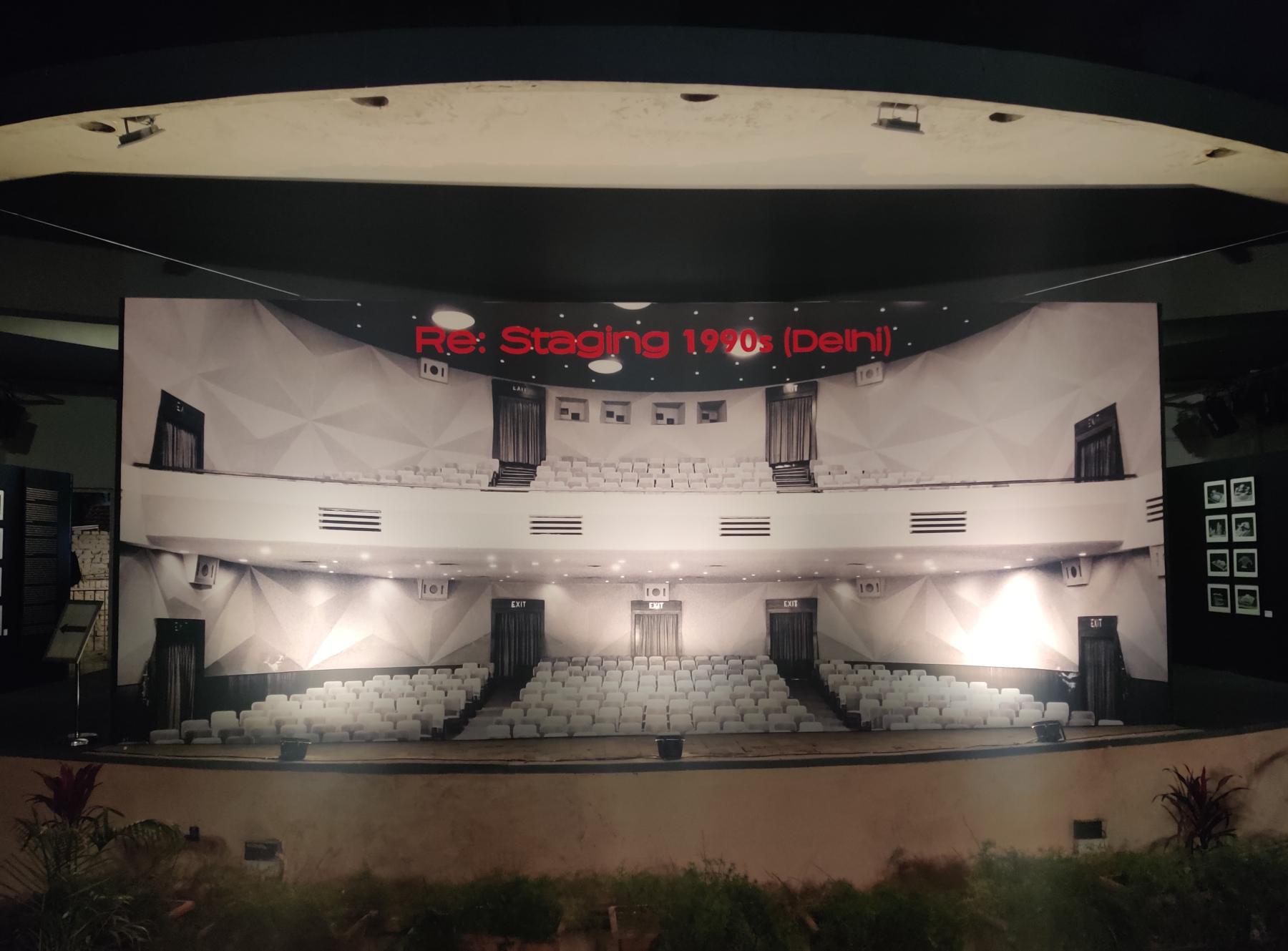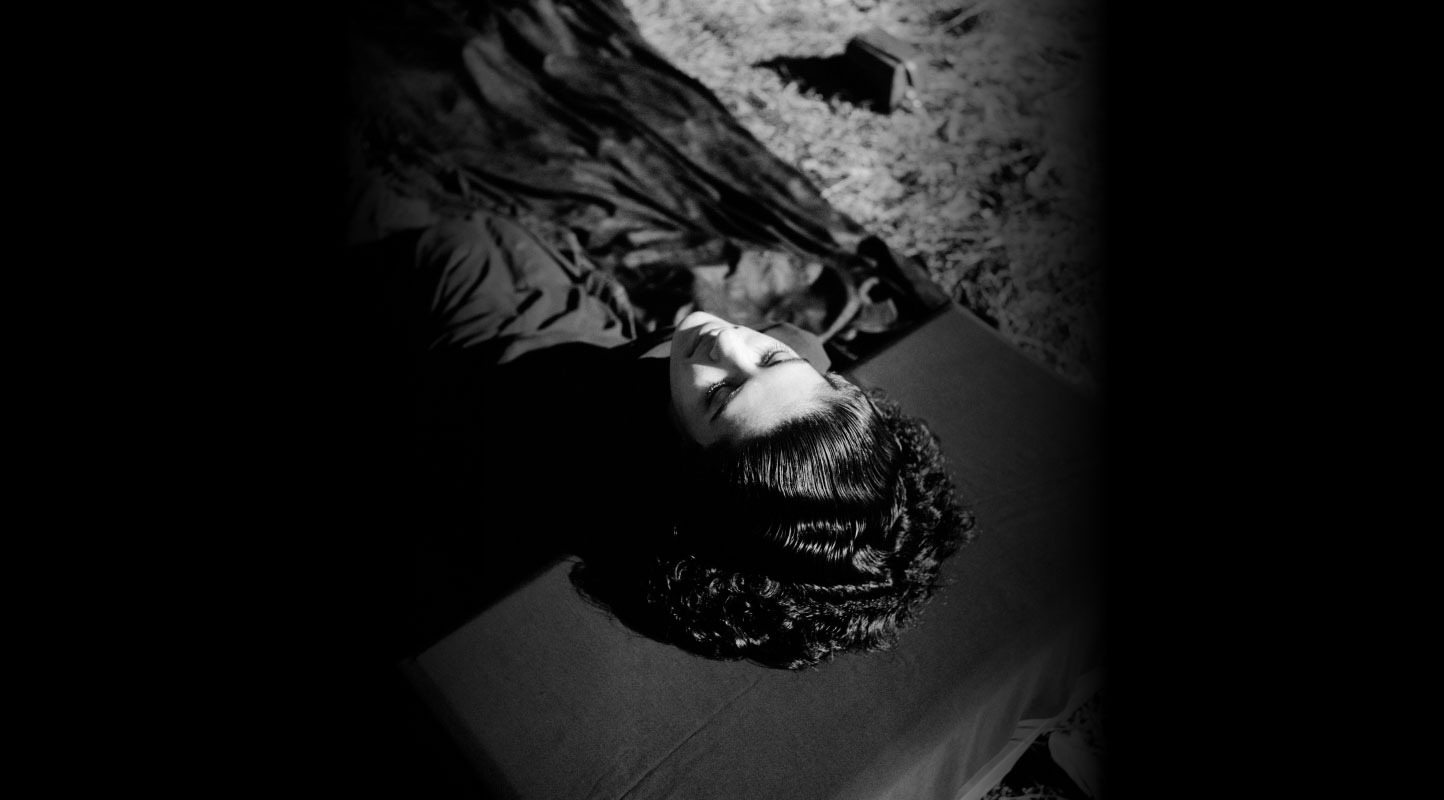On Theatre and Architecture: Re: Staging 1990s (Delhi)
Zuleikha Chaudhari introduces the panel "Rights as Public Rehearsal" at the opening of the exhibition. (Triveni Kala Sangam, Delhi, 1 February 2025.)
Re: Staging 1990s (Delhi), an exhibition presented by the Alkazi Theatre Archives and the Alkazi Collection of Photography, made thoughtful interconnections across theatre and historical events by examining significant economic, political and cultural shifts during the decade of the 1990s. On view from 1–10 February 2025 at the Triveni Amphitheatre, Triveni Kala Sangam, in conjunction with the India Art Fair, the exhibition foregrounded the use of the architectural/theatrical model as an investigative tool. In her introduction, Zuleikha Chaudhari shared pertinent questions that the exhibition sought to engage with: “How the did stage work as a mode of cultural action, providing an arena for practitioners to interact with audiences, the market, the government and cultural establishments?” “How can we investigate critical and creative, theatrical perspectives in the events of that decade in order to develop a critical and creative relation to the politics of the present?”

A diorama of the "Protest against Article 377, 1991" from the exhibition Re: Staging 1990s (Delhi). (Photograph by the author.)
Re: Staging 1990s (Delhi) is part of an ongoing series of exhibitions by the Alkazi Theatre Archives and the Alkazi Collection of Photography. In her introductory note on the 2024 exhibition ‘Re: Public Theatre and Architecture in Central Delhi (1950s-1970s),’ Chaudhari reflected on the notion of ‘rehearsal’ as an “untidy process of thought and consideration with related notions of contingency, interruption, uncertainty, version, repetition, and failure.” In offering the possibility of the practice of rehearsal to become “a link between aesthetic judgement and social or institutional critique,” she set the tone for a broader inquiry into the interplay between performance, politics and the historical event. Within this frame, the exhibition positioned itself as a provocation—the 1990s as a rehearsal stage for the first decade of the twenty-first century—where theatre becomes both witness to and a participant in key cultural and historical shifts. Within the exhibition, key events like LK Advani’s Ram Rath Yatra (1991), the Central Market bomb blasts (1996) and protests against Section 377 (1991) are rendered into architectural models set on top of a hand drawn map of Central Delhi, with a backdrop of a timeline of theatre in relation to economic and political events of the 1990s—as if the nation is playing itself out on a stage. Here, the model operated as a conceptual instrument that registers “distortion, repetition and feedback” to suggest that history itself is perpetually restaged. This provocation allows us to view theatre and history as contingent performances—and rehearsal not as preparation but as a critical mode of staging unfinished negotiations of history.
Ram Rahman shares the journey of Safdar Hashmi Memorial Trust (SAHMAT) as part of the panel "Rights as Public Rehearsal." (Triveni Kala Sangam, Delhi, 1 February 2025.)
To reflect further on these questions, Re: Staging opened with a talk titled “Rights as Public Rehearsal” with Ram Rahman, Ritam Sengupta and Sarover Zaidi. The speakers resonated with the interconnection between cultural freedom, dramaturgy and architectural form—a staging as it were. In sharing the journey of the Safdar Hashmi Memorial Trust (SAHMAT), Rahman brought to light the shrinking access to public spaces, especially streets, which has also led to the shrinking of the medium of street theatre. He presented the journey of SAHMAT, which was formed in 1989 by a group of artists, activists, theatre people, musicians and writers in the memory of street theatre activist Safdar Hashmi. Rahman’s presentation, accompanied with photographs by himself and others from the trust, focused on SAHMAT’s commitment towards “keeping the arts community progressive, fighting for the freedom of expression and against communal politics.” SAHMAT continues to commemorate Hashmi’s legacy by organising an annual memorial event on the 1st of January every year in Delhi. The themed annual event is staged on Safdar Hashmi Marg. Using tents covered with posters designed by artists, the cultural programme includes street theatre performances, as well as a lecture by leading historians, social scientists, economists or theorists of the time. Alongside this, the presentation gave us a peek into the myriad activities of the Trust as its presence expands across the country. One such event that caught the attention of the audience was a 17 hour Sufi Bhakti event organised in Ayodhya next to the Babri Masjid demolition site, in a tent designed by architect Romi Khosla. Rahman also shared their struggles with government forces, whether police or the administration, including their eight-year long legal battle after the 1993 Hum Sab Ayodhya (We Are All Ayodhya) exhibition which was a tremendous victory in the fight for freedom of expression.
Sarover Zaidi speaking on archive as reclamation as part of the panel "Rights as Public Rehearsal." (Triveni Kala Sangam, Delhi, 1 February 2025.)
Zaidi evoked the memory of the Shrine of Nanhe Miyan at the Triveni Mandi House circle which was demolished overnight during the G20 clearing and beautification of Lutyens Delhi. “It’s like it never existed,” says the shrine keeper. She constructed a scenography of growing up in Delhi of the 1990s to examine the erasure of memory, spaces and histories through demolition and urban transformation that continue to modify the public sphere even today. For her, the 1990s are marked by the demolition of the Babri Masjid in 1992, bomb blasts, surveillance paranoia and the resulting “blankness of memory” that the next generation inherited from this decade. The dioramic form used by the Alkazi Theatre Archive is of specific interest then as they offered material testimony to the erasure of material spaces and allowed for a revisualisation of the city. Citing the Right to Food Act and Naz Foundation (India) Trust’s 2001 petition challenging the constitutionality of Section 377 of the IPC which criminalises homosexual acts between consenting adults, both of which are part of the post liberalisation development and NGO landscape, Zaidi remarked on the shifting ways of thinking of ‘rights.’ These were characterised by embedding the language of rights within a language of NGOs evident in the introduction of new terms like ‘communitisation’ and ‘community building’ in this period.
Ritam Sengupta at the panel "Rights as Public Rehearsal." (Triveni Kala Sangam Delhi, 1 February 2025.)
Ritam Sengupta reflected on the significance of the Alkazi Theatre Archives as a repository, especially in understanding theatre’s role within the context of neoliberal reforms, decentralisation and the rise of the Hindu Right. By highlighting key policies and economic reforms of the 1990s such as the New Economic Policy (1991), the 73rd and 74th Amendments (1993), the Haksar Committee report (1990) and the introduction of corporate funding for theatre, which redefined its role and subjected it to the “demands of marketability,” Sengupta excavated the policy and market forces that background various theatrical responses. In introducing the concept of ‘dramaturgical surplus’ Sengupta elaborated on the spread of performance across various sectors, from the stage to politics and media, resulting in the dilution of theatre’s direct engagement with the public.
Installation view of architectural models depicting key historical events from the 1990s set on top of a hand drawn map of Central Delhi at the exhibition Re: Staging 1990s (Delhi).
The conversation highlighted the historic continuity of the 1990s as a pivotal decade that laid the foundation for contemporary social, cultural, economic and political conditions. Economic liberalisation, demolition of the Babri Masjid and the rise of majoritarian politics redefined public life, while the shrinking of public spaces, increased social surveillance and mediatisation of the public sphere reconfigured how performance, political engagement and collective expression operate today.

Backdrop for the panel "Rights as Public Rehearsal." (Triveni Auditorium, Triveni Kala Sangam, Delhi, 1 February 2025. Photograph by the author.)
To learn more about theatre, read Prabhakar Duwarah’s album on Sridhar Balasubramaniyam’s documentation of the theatre troupe Manalmagudi Theatre Land, Arushi Vats’ essay on the SAHMAT Collective and Samira Bose’s reflections on the influence of Nilima Sheikh’s work in theatre design on the artists’ practice.
All images by Vijay Kumar and courtesy of the Alkazi Theatre Archives unless otherwise mentioned.




